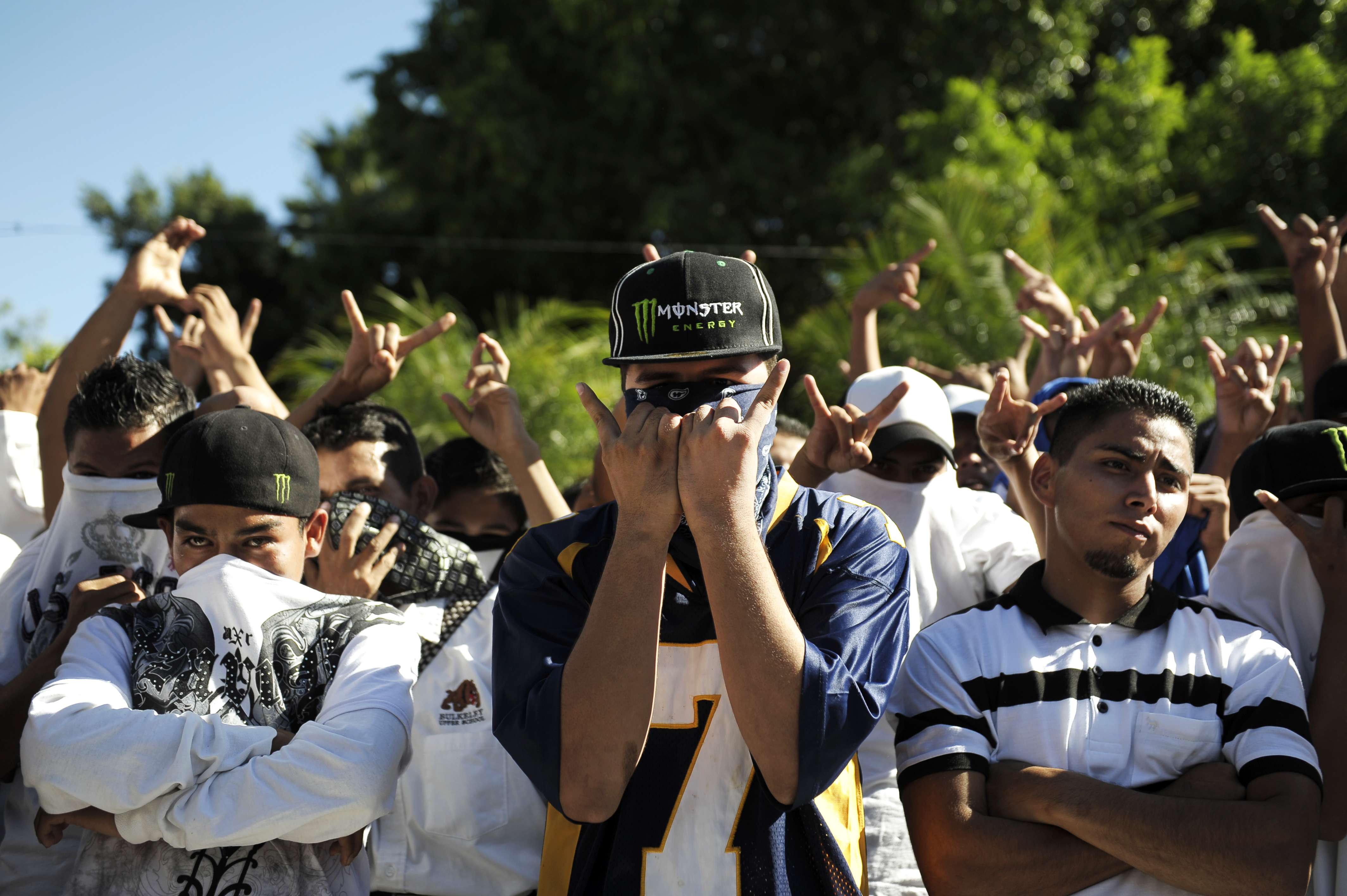The rise of MS-13
President Trump has vowed to defeat the "savage" street gang and to deport its members. Where did it come from?

President Trump has vowed to defeat the "savage" street gang and to deport its members. Where did it come from? Here's everything you need to know:
What is MS-13?
It's the only street gang designated by the U.S. government as a "transnational criminal organization," with some 10,000 members in the U.S. and another 80,000 in Central America. Also known as Mara Salvatrucha, or "Salvadoran street posse," MS-13 is involved in drug dealing, extortion, robbery, and human trafficking across the Americas. Its mostly ethnic Salvadoran, Honduran, and Guatemalan members are often identified by their elaborate tattoos and are notorious for their brutality. To become full-fledged "homeboys," teenage initiates must murder a rival gang member, and then undergo a 13-second beatdown by their compatriots. Violence is used unsparingly: Enemies are tortured and cut to pieces, their relatives raped and murdered. A former Massachusetts gang member turned FBI informer, identified only as Clacker, testified that MS-13's weapon of choice is a machete, because it doesn't bring police sirens. "With a machete you can cut somebody's head off easily," he said, "and that person will not scream." President Trump has made MS-13 his public enemy No. 1, and several hundred suspected members were arrested last year and hundreds more deported. "They're animals," said Trump. "They're going back to their country, period."
The Week
Escape your echo chamber. Get the facts behind the news, plus analysis from multiple perspectives.

Sign up for The Week's Free Newsletters
From our morning news briefing to a weekly Good News Newsletter, get the best of The Week delivered directly to your inbox.
From our morning news briefing to a weekly Good News Newsletter, get the best of The Week delivered directly to your inbox.
How did it start?
The gang was founded in Los Angeles in the 1980s by migrants fleeing El Salvador's civil war, which pitted a U.S.-backed military regime against Marxist rebels. Landing in neighborhoods dominated by black and Mexican gangs, the new arrivals banded together to defend themselves. When the gang population in California's prisons soared in the 1990s, the Clinton administration deported some 20,000 criminals to El Salvador. But the impoverished country was unable to cope with the influx, and MS-13 took over whole neighborhoods, then spread to neighboring Honduras and Guatemala. Murder rates soared across the region, and eventually a new wave of refugees fled north to the U.S. Perversely, MS-13 profits from this: It controls human trafficking across the Guatemalan-Mexican border.
Where is the gang in the U.S.?
MS-13 is still strong in Los Angeles, and now operates in at least 46 states and Washington, D.C. On Long Island, New York, alone, police said, the gang was responsible for at least 17 murders in 17 months over 2016 and 2017. Their victims included Kayla Cuevas, 16, and Nisa Mickens, 15, who were attacked in the street with baseball bats and machetes; Kayla had been feuding with MS-13 members at Brentwood High School. Four fellow students were charged with the murders, three of them undocumented immigrants. The bloodshed led Trump to announce a crackdown on the gang, which he said was fueled by illegal immigration. In his State of the Union address, the president said many MS-13 members take "advantage of glaring loopholes in our laws to enter the country as unaccompanied alien minors."
A free daily email with the biggest news stories of the day – and the best features from TheWeek.com
Do many enter that way?
It's unclear. In 2014, more than 52,000 unaccompanied minors from Central America poured across the U.S.-Mexican border. But most were fleeing MS-13, which forces young women into prostitution and demands boys become gang members, or else. Carla Provost, acting chief of the U.S. Border Patrol, told Congress last year that of the 250,000 unaccompanied minors apprehended at the border since 2011, only 56 were suspected MS-13 members. Indeed, most of MS-13's members are U.S. citizens, says criminologist David Pyrooz, who notes that immigrants are less likely than native-born youth to join gangs. But MS-13 is "the perfect bogeyman," he says, because of its members' ethnicity and extreme violence. He and other experts worry the government's actions might empower MS-13.
How could that happen?
MS-13 has a smaller presence in the U.S. than the Latin Kings and Crips gangs, which have up to 35,000 members each. But Trump's frequent statements about MS-13, says Pyrooz, give the gang "a notoriety that it could never achieve on its own," helping it attract new recruits. It may have received another boost in January, when the Trump administration rescinded the temporary protected status that since 2001 has allowed some 200,000 Salvadorans to remain in the U.S. Rather than return to El Salvador, many of those migrants might go underground in the U.S. Afraid to go to the police in case they end up being deported, these Salvadorans could become easy extortion targets for MS-13.
What's the best way to combat MS-13?
Three law enforcement leaders from communities struggling with MS-13–related violence told Congress last year that they wanted a two-pronged approach that involved more funding for anti-gang units and for community-based programs that support unaccompanied child migrants. These children are vulnerable to recruitment, said Timothy Sini, then police commissioner for Long Island's Suffolk County, because they are "adjusting to a new country" and are "seeking a sense of belonging." Another option is to fight the gang at the source, in El Salvador, the way the U.S. helped Colombia end its long-running leftist insurgency, says Daniel Runde of the Center for Strategic and International Studies. Nearly half the population of El Salvador is under age 24. "The region needs to create jobs," Runde said, to offer "a viable alternative to joining gangs — or deciding to leave for the U.S."
Bloodshed behind bars
The nationwide crackdown on MS-13 has had an unforeseen side effect — a rise in violence and extortion in America's prisons. At Virginia's Fairfax County jail, where MS-13 has grown from less than 20 members a year ago to 40 today, big gang fights that used to happen twice a year have become a monthly occurrence. At Prince George's County jail in Maryland, MS-13 shakes down other inmates for a protection "tax," a tactic that has triggered fierce turf wars with rival gangs. MS-13 controls "the Hispanic population," a Prince George's investigator told The Washington Post. "They make them join with them in fights." For prison officials, it's a constant battle to identify which inmate belongs to which gang — members generally try to hide their affiliations from the authorities — and then to separate MS-13 members from one another and from rival outfits. Maj. Mandy Lambert, from Virginia's Prince William County jail, says the process is "very logistically challenging."
-
 How to financially prepare for divorce
How to financially prepare for divorceThe Explainer Facing ‘irreconcilable differences’ does not have to be financially devastating
-
 Why it’s important to shop around for a mortgage and what to look for
Why it’s important to shop around for a mortgage and what to look forThe Explainer You can save big by comparing different mortgage offers
-
 4 ways to save on rising health care costs
4 ways to save on rising health care costsThe Explainer Health care expenses are part of an overall increase in the cost of living for Americans
-
 Bari Weiss’ ‘60 Minutes’ scandal is about more than one report
Bari Weiss’ ‘60 Minutes’ scandal is about more than one reportIN THE SPOTLIGHT By blocking an approved segment on a controversial prison holding US deportees in El Salvador, the editor-in-chief of CBS News has become the main story
-
 Has Zohran Mamdani shown the Democrats how to win again?
Has Zohran Mamdani shown the Democrats how to win again?Today’s Big Question New York City mayoral election touted as victory for left-wing populists but moderate centrist wins elsewhere present more complex path for Democratic Party
-
 Millions turn out for anti-Trump ‘No Kings’ rallies
Millions turn out for anti-Trump ‘No Kings’ ralliesSpeed Read An estimated 7 million people participated, 2 million more than at the first ‘No Kings’ protest in June
-
 Ghislaine Maxwell: angling for a Trump pardon
Ghislaine Maxwell: angling for a Trump pardonTalking Point Convicted sex trafficker's testimony could shed new light on president's links to Jeffrey Epstein
-
 The last words and final moments of 40 presidents
The last words and final moments of 40 presidentsThe Explainer Some are eloquent quotes worthy of the holders of the highest office in the nation, and others... aren't
-
 The JFK files: the truth at last?
The JFK files: the truth at last?In The Spotlight More than 64,000 previously classified documents relating the 1963 assassination of John F. Kennedy have been released by the Trump administration
-
 'Seriously, not literally': how should the world take Donald Trump?
'Seriously, not literally': how should the world take Donald Trump?Today's big question White House rhetoric and reality look likely to become increasingly blurred
-
 Will Trump's 'madman' strategy pay off?
Will Trump's 'madman' strategy pay off?Today's Big Question Incoming US president likes to seem unpredictable but, this time round, world leaders could be wise to his playbook